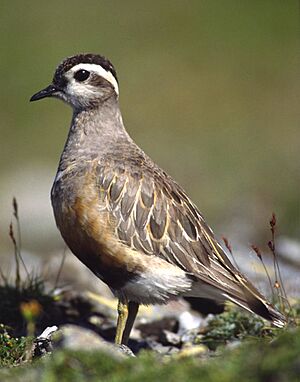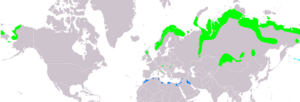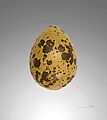Eurasian dotterel facts for kids
Quick facts for kids Eurasian dotterel |
|
|---|---|
 |
|
| Conservation status | |
| Scientific classification | |
| Genus: |
Eudromias
|
| Species: |
morinellus
|
 |
|
| Range of C. morinellus
Breeding Passage Non-breeding |
|
The Eurasian dotterel (Eudromias morinellus) is a small wader bird. It belongs to the plover family. In Europe, it is often just called the dotterel. This bird is the only species in its genus, Eudromias.
Dotterels have brown and black stripes. They have a wide, white stripe above their eyes. When they are ready to breed, they show an orange-red band on their chest. Female dotterels are usually more colorful than males. These birds are known for being very trusting and not easily scared. Because of this, the word "dotterel" was sometimes used to describe a foolish person.
The Eurasian dotterel is a migratory bird. It breeds in Northern Europe and Eurosiberia. In winter, it flies south to North Africa and the Middle East. It makes its nest in a simple scrape on the ground. The female lays two to four eggs. The male bird does most of the work, incubating the eggs and raising the chicks. Often, the female will leave to find another male and lay more eggs. This bird is quite common and lives in many places. The International Union for Conservation of Nature says it is a species of "least concern", meaning it is not currently at risk.
Contents
About the Dotterel's Name
How the Dotterel Got Its Scientific Name
The Eurasian dotterel was first described in 1758. This was done by a Swedish naturalist named Carl Linnaeus. He gave it the scientific name Charadrius morinellus. Later, scientists moved the dotterel to a new genus called Eudromias. This happened after studies showed that the Charadrius group was not quite right.
The genus name Eudromias comes from Ancient Greek. It means "good runner". The species name morinellus also comes from Ancient Greek. It means "foolish". This name was given because of the bird's trusting nature.
The English Name and Its History
The English name "dotterel" has been used since the 1440s. It referred to the bird and also to someone considered simple or foolish. It's not clear which use came first. The link is the bird's trusting nature, which made it easy to catch. Its Scottish Gaelic name, amadan-mòintich, means "fool of the moors."
In the past, people hunted dotterels. King James VI and I used to go to Royston, Hertfordshire, to shoot them. They were also easy prey for illegal hunting, which reduced their numbers. Dotterels were also seen as a special food. In 1534, Queen Anne Boleyn received "a brace of dotterels" as a gift.
What Does a Dotterel Look Like?
This plover is smaller than the European golden plover. It has a clear whitish stripe above its eye in all its different plumages. When it flies, its wings look plain. Adult dotterels in summer are easy to spot. They have a chestnut-colored chest with a white border above it. Their belly is black, and their back is warm brown.
Their legs are yellow, and their short beak is black. Just like with phalaropes, the female dotterel is brighter in color than the male. In winter, the birds lose their rich colors on their undersides. They become greyer on top, but still have the white chest line. Young birds look similar but have a scaly pattern on their backs. Their flight call is a soft pyurr. The female's song is a simple, repeated whistle.
Where Do Dotterels Live and Travel?
Dotterels breed in the Arctic tundra of northern Eurosiberia. This area stretches from Norway all the way to eastern Siberia. They also breed on high mountain plateaus, like those in the Scottish highlands and the Alps.
These birds are migratory. They spend their winters in a narrow band across northern Africa. This area goes from Morocco in the west to Iran in the east. They often stop at the same places during their migration. Small groups of dotterels, called "trips," pass through these inland farm or grassy areas each year. Their winter homes are usually semi-desert areas.
Dotterel Behavior and Life Cycle
What Do Dotterels Eat?
The dotterel's diet mainly consists of insects. They also eat other small invertebrates. These include snails, worms, and shellfish. They find their food by running a bit, then pausing, and then running again. This is different from how some other waders find food, which often involves steady probing into the ground.
Dotterel Reproduction
The male dotterel usually takes care of incubating the eggs. He also looks after the chicks once they hatch. In most cases, the male dotterel makes sure that other males do not mate with his female. He typically raises chicks that are his own. Only a very small number of chicks (about 4.6%) were found not to be related to the male caring for them.
Dotterel Conservation Status
The Eurasian dotterel is a fairly common bird. It lives in a very wide area. Its numbers seem to be slowly going down, but not at an alarming rate. Because of this, the International Union for Conservation of Nature has listed it as a "least-concern species".
A study from 2015 showed a drop in dotterel numbers in Scotland. Between 1987 and 2011, the number of breeding males fell from 980 to 423. This was a decline of 57%. The Eurasian dotterel is one of the birds protected by the Agreement on the Conservation of African-Eurasian Migratory Waterbirds. This agreement helps protect waterbirds that migrate across Africa and Eurasia.
Images for kids








